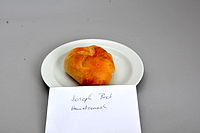Kaiser roll
This article includes a list of general references, but it lacks sufficient corresponding inline citations. (February 2013) |
You can help expand this article with text translated from the corresponding article in Czech. (March 2024) Click [show] for important translation instructions.
|
 | |
| Alternative names | Vienna roll, hard roll, water roll |
|---|---|
| Type | Bread roll |
| Place of origin | Austria |
| Region or state | Vienna |
| Main ingredients | Flour, barm, malt, water, salt |
| Variations | Michetta, rosetta |
| 200 (100 g) kcal | |
| Other information | glycaemic load 40 (100 g)[1] |
The Kaiser roll (Emperor roll, German: Kaiserbrötchen (German: [ˈkaɪ̯zɐˌbʁøːtçən] ⓘ), Slovene: kajzerica, Polish: kajzerka), also called a Vienna roll (Wiener Kaisersemmel; as made by hand also: Handsemmel), or a hard roll, is a typically round bread roll, originally from Austria. It is made from white flour, yeast, malt, water and salt, with the top side usually divided in a symmetric pattern of five segments, separated by curved superficial cuts radiating from the centre outward or folded in a series of overlapping lobes resembling a crown.[2] The crisp Kaisersemmel is a traditional Austrian food officially approved by the Federal Ministry of Agriculture.[3]
Origin[edit]

Kaiser rolls have existed in a recognizable form since at least 1760. They are thought to have been named to honor Emperor (Kaiser) Franz Joseph I of Austria (born 1830, reigned 1848–1916). There is also the theory that the name stems at least in part from a baker family called Kayzer in Opatów in Galicia which had been occupied by the Austrian monarchy in the First Partition of Poland.[4] In the 18th century a law fixed retail prices of Semmeln (bread rolls) in the Habsburg monarchy. Allegedly, the name Kaisersemmel came into general use after the bakers' guild sent a delegation in 1789 to Emperor Joseph II (b. 1741, r. 1765–1790) and convinced him to deregulate the price of bread rolls.[citation needed]
With its monarchical connotation, Kaiser rolls stood out against common rolls known as Mundsemmeln ("mouth rolls") or Schustersemmeln ("cobbler's rolls"). They are traditionally found in Austria, but have also become popular in other countries of the former Austrian Habsburg Empire, such as the Galicia region in Poland and later the whole country (where it is known as kajzerka), Croatia, Slovenia, and Serbia (kajzerica), Hungary (császárzsemle), the Czech Republic (císařská žemle, císařská houska,[5] kaiserka) and Slovakia (kaiserka), as well as in Germany, the United States, and Canada. During Austrian rule in Lombardy, Italian bakers produced a hollow version known as michetta or rosetta.
Variations[edit]
A handmade Kaiser roll is known as a Wiener Kaisersemmel (Handsemmel) according to the Codex Alimentarius Austriacus standards collection.[6]
There are multiple variants of the common roll, differing in size, type of flour used, and toppings. While traditionally plain, Kaiser-style rolls are today found topped with poppy seeds, sesame seeds, pumpkin seeds, flax, or sunflower seeds. The Kaiser roll is a main part of a typical Austrian breakfast, usually served with butter and jam. It is often used as a bun for such popular sandwiches as hamburgers in America, and with a slice of Leberkäse in Germany and Austria, though sliced Extrawurst and pickled gherkins (Wurstsemmel), or a type of Wiener schnitzel (Schnitzelsemmel) are also used. A variation called a kümmelweck (alternatively spelled "kimmelweck" or "kummelweck")[7] is topped with kosher salt and caraway, and in the United States is an essential component of a Buffalo-area specialty, the beef on weck sandwich.
In much of eastern New York State — New York City, Long Island, the Hudson Valley and the Adirondacks — and throughout New Jersey Pennsylvania, Maryland, Delaware, and Connecticut, Kaiser rolls are known as "hard rolls" or, rolls, and are staples of delicatessen and convenience stores.
The Wisconsin variety of "hard roll", which was formed over the decades by the bakeries of Sheboygan to be paired with the local specialty of bratwurst (either in a long single bun or circular "double brat" roll), features a fluffy consistency on the inside with a crust on the crown of the bun, though most of the steps and some ingredients in the creation of Sheboygan hard rolls are proprietary, and can vary by each bakery's own recipe.[8][9]
-
Handsemmel
-
A beef on weck sandwich
See also[edit]
References[edit]
- ^ "Glycemic index and glycemic load for 100+ foods". Harvard Medical School. August 27, 2015. Retrieved February 20, 2018.
- ^ How To Shape Kaiser Rolls. Keiser University (Culinary Arts). November 19, 2013. Event occurs at 0.06. Archived from the original on December 12, 2021. Retrieved January 20, 2021.
- ^ List of traditional foods, entry No. 164 (in German) Archived 2013-11-12 at the Wayback Machine
- ^ Radoslaw, Kubicki. "The city of Opatow and Opatöw landed estates under Austrian rule (1794 - 1809)" (PDF). Retrieved March 31, 2023.
- ^ HUGO, Jan. Slovník nespisovné češtiny: argot, slangy a obecná mluva od nejstarších dob po současnost : historie a původ slov. Praha: Maxdorf, c2006, s. 160; HUGO, Jan. Slovník nespisovné češtiny: argot, slangy a obecná mluva od nejstarších dob po současnost : historie a původ slov. Praha: Maxdorf, c2009, s. 184; Příruční slovník německo-český = Deutsch-tschechisches Handwörterbuch, Janko Josef a Siebenschein Hugo, V Praze: Státní nakladatelství, 1939-1940, s. 508; Příruční slovník jazyka českého. V Praze: Státní nakladatelství, 1935-1957, s. 258.
- ^ Codex Alimentarius Austriacus, chapter B18, subchapter 2.2.2 (in German)
- ^ "kummelweck". Wiktionary. Retrieved July 10, 2020.
- ^ "All about Buns". Retrieved October 15, 2019.
- ^ "Sheboygan Rolls at City Bakery LLC in Sheboygan, WI". City Bakery, Sheboygan, Wisconsin. Retrieved October 15, 2019.


